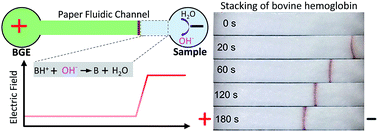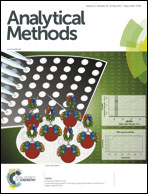Two orders of magnitude electrokinetic stacking of proteins in one minute on a simple paper fluidic channel†
Abstract
A crucial challenge in development of robust paper-based analytical devices (PADs) is the lack of sensitivity. Electrokinetic stacking is a kind of unique sample preconcentration for low-abundant charged species, which can be integrated to PADs to enhance the sensitivity. In this work, we bring new insights into the mechanism underlying an electrokinetic stacking technique based on a field amplified stacking (FAS) effect implemented on a simple paper fluidic channel. Here, we reveal that the acid–base titration reaction between the cations/anions in the background electrolyte (BGE) and the OH−/H+ ions from water electrolysis plays an essential role in the development of the electric field gradient. This was experimentally confirmed by changing the BGE type, monitoring the current variation and pH characterization. Based on the new knowledge, the paper-based FAS was successfully extended to stack cationic analytes. Eventually, a model protein of bovine hemoglobin (BHb) in its anion form was 150-fold stacked within 60 s. This work shows that the sensitivity of PADs can be greatly enhanced with effective use of this simple and low cost electrokinetic stacking technique.



 Please wait while we load your content...
Please wait while we load your content...